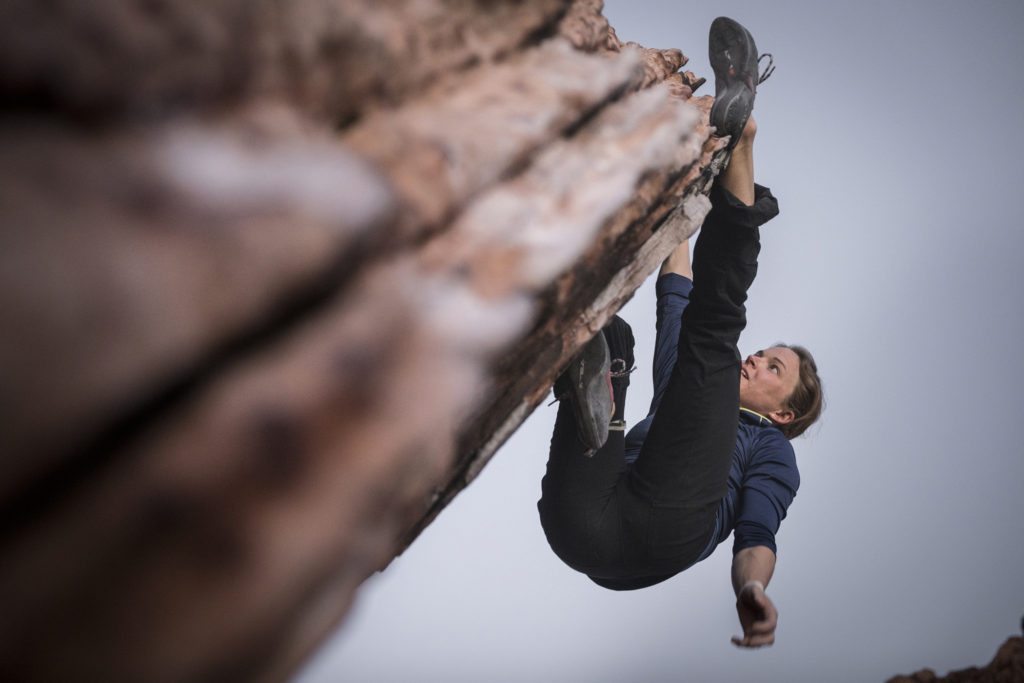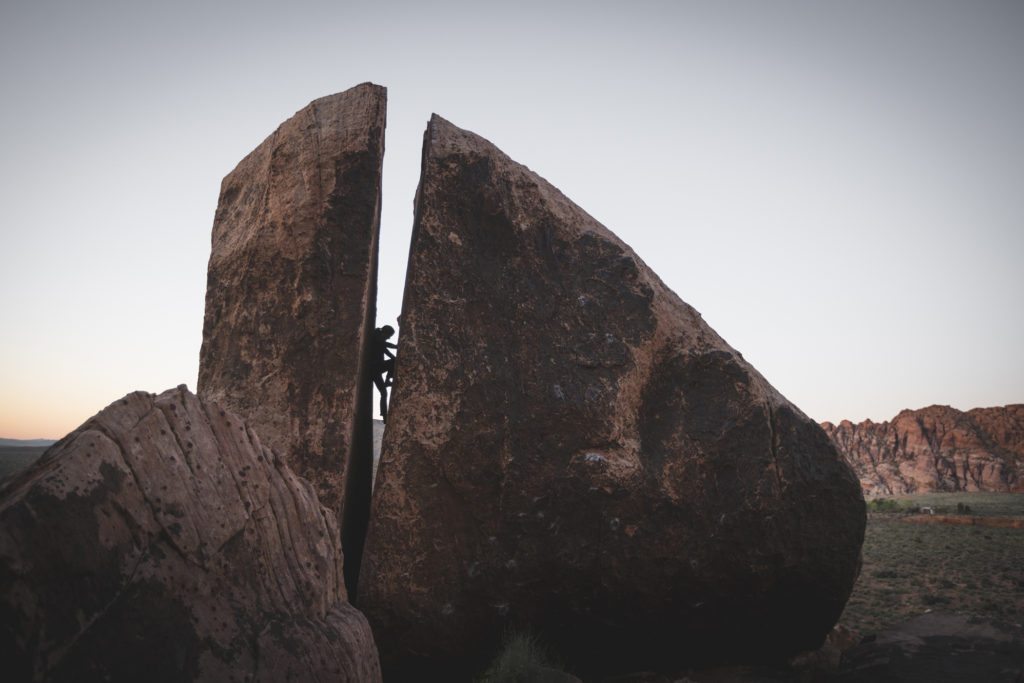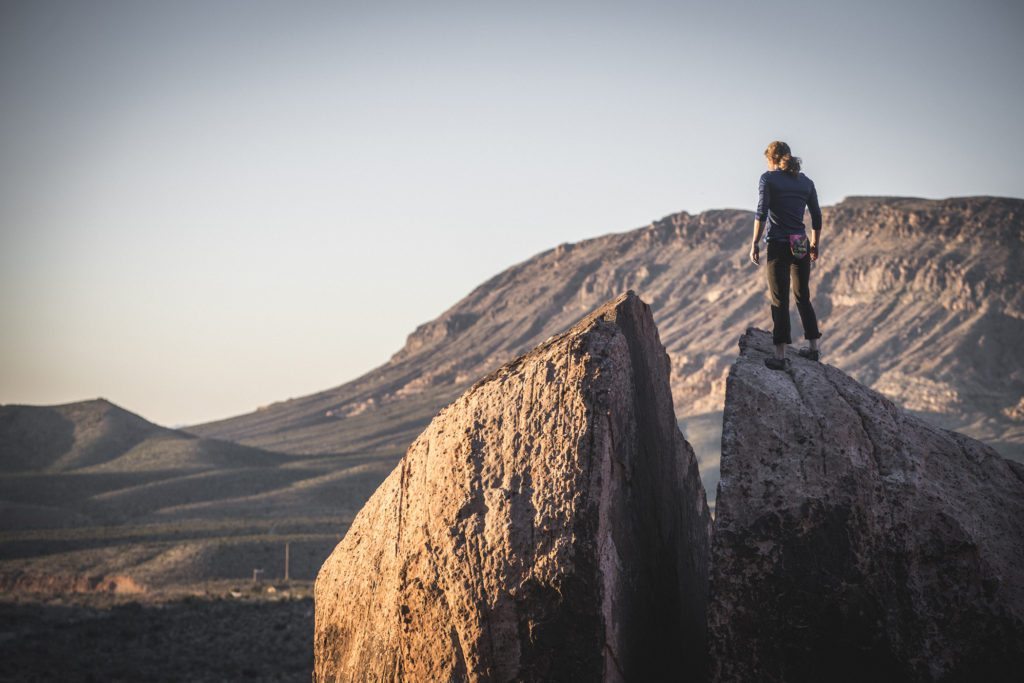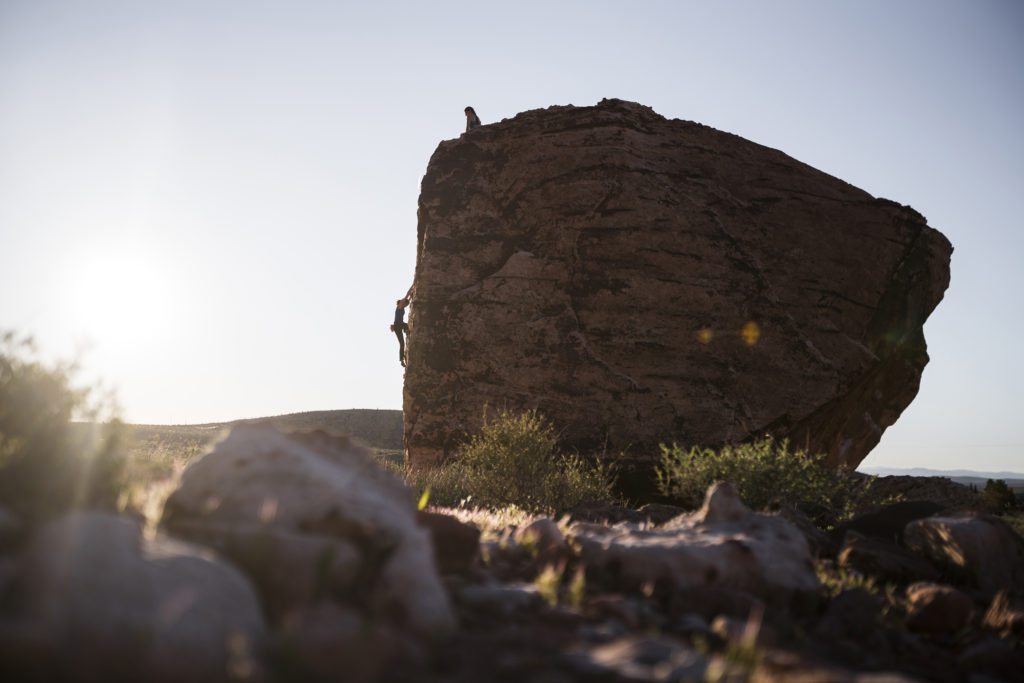Climbing and advocacy are two things that are close to my heart. Protecting and giving back to the places that I’m so lucky to play in is something I feel really passionate about. Mountain Hardwear posted about Save Red Rock last month with one of their athletes, Angie Payne. I got to sit down—well, send off millions of questions via email more like it—with Angie to ask her a few questions around being a professional athlete, stewardship, and advocacy.
As a pro climber, do you think that you have more or different responsibilities than other climbers in terms of conservation, public lands, and access issues?
I don’t know that I have more responsibilities, but my role does involve some responsibilities that might be different than that of a climber not in the public eye. I feel a certain amount of responsibility to set a good example for my peers and the younger generation. Maybe “opportunities” is a better word than “responsibilities.” I don’t think that it is very productive to single groups of people out in a community as the ones who have to be more/less responsible, because in theory it is best if everyone takes responsibility for conservation, public lands and access issues.
As a pro climber, I do realize that my actions have the potential to be more visible in today’s world.
I know that other climbers, particularly younger ones, might be influenced by my actions, and I feel like I have a serious responsibility to set a good example. That doesn’t mean that I’m perfect, of course. I have made mistakes in the past regarding access issues and conservation. I think that having access to a portion of the community—through social media followers, for example—also comes with the opportunity to reach an audience and the responsibility to use that platform wisely and for the betterment of the community.
I don’t think that being in the public eye is what should motivate me to support and be vocal about these issues. I should support them because I genuinely care about them, not just so I can post something on social media about it. I should use the access I have to the community to encourage people to get involved. I think my responsibility is to tell stories about the places I have a connection to in order to illuminate the bigger issue of the threat to public lands.
If an athlete doesn’t care or won’t engage, how can we get them to?
That’s a pretty tough question, because I think in many cases, people take these public lands for granted. I certainly have in the past and still do sometimes. For me, I always connect more with the issue once I’ve actually been to a place and experienced it. I don’t think that a person can be forced to care about an issue or a place, it takes a personal experience or realization to cause someone to want to get involved. These questions have been pretty hard for me to answer, in all honesty, because I feel like I have just gotten to that place of really wanting to engage in these issues over the last few years.
For a long time, I took the climbing areas I visited for granted, and just assumed the public lands would always be available to me for climbing on and enjoying.
For better or worse, it has taken the recent shake-up in the political atmosphere and the increased threat to public lands—and probably a little bit of getting older and more mature—to wake me up and realize that these places might not always be there. I first cared about these places because of the rocks. I didn’t look much beyond the boulders in my early years of outdoor climbing. Slowly, I woke up to the world around those boulders. It just took time, experience, a change of perspective, and shifting priorities for me to get to a place where it wasn’t all about the boulders. Those aren’t things that you can force on a person.
There have been a number of pro-athletes lately who have been called out for violating conservation or access ethics. What do you think is the best way a regular person could go about approaching the pro-athlete about their behavior? How would you like to be approached on the topic if you were violating LNT or contributing to access issues?
I have seen this play out numerous times on social media. It often gets messy. I think that the best way for a person to approach a pro athlete about a behavior they have a problem with is the same as the best way to approach any other non-pro. That is one of the things about the climbing community that is somewhat unique. The “pros” are super accessible and usually aren’t elevated to some absurd celebrity status. I think that face-to-face discussion would be best. Things are less likely to get messy or misinterpreted when the people who are talking aren’t separated by distance and computer screens. If face-to-face discussion isn’t possible, there are many ways to get ahold of people in today’s hyper-connected world. Laying out the issue in a respectful, calm way is probably going to be more productive than the alternative.
I hope that if someone saw me behaving in a way that they felt was unacceptable or irresponsible, they would feel that I am approachable enough to converse with them about the issue. If we want to maintain access to the climbing areas we love, we all need to be held to a high standard of behavior and be held accountable when that behavior does not meet that standard.
What do you think is the responsibility of brands around access issues? Should sponsors encourage their athletes to be more involved? Mountain Hardwear has their new Impact Initiative program and ambassadors doing sustainable things around the globe. Do you think sponsors should select for athletic ability in addition to work around sustainability or conservation?
I know very little about marketing strategy, so I don’t want to try to speak too much to that part of the question. I guess this really depends on the company and what they want to accomplish. The type of athletes a company wants to support also has a lot to do with what demographic the company is trying to reach. It is cool when companies give athletes opportunities to get involved in access issues, because that might help introduce the athletes to issues they weren’t aware of. However, you can’t force a person to care about something, and in order for the public to get on board with what that company or athlete is promoting, the support and promotion of the issue on the part of both the athlete and the company needs to be genuine. I think that brands have a responsibility to promote and support access issues, since they have a great deal of power in the industry, and the industry has power in the economy. We have seen a fair amount of this recently surrounding the public land issues in Utah and the Outdoor Retailer tradeshow. Brands have power to affect access and conservation issues, and it would be a shame if they didn’t exercise that power when public lands are at stake.
With the current administration in place for at least the next four years, how do you think this affects conservation efforts?
I will start by saying that I don’t consider myself all that knowledgeable about politics or conservation and have only recently started to follow either very closely. It seems pretty obvious that the current administration is not going to prioritize the protection or conservation of the environment, which could have a devastating effect on a lot of things, to say the least.
At the same time, the recent election and the actions of the new administration seem to have ignited a new vigor to protect the things that we value.
This is the first time I have seriously paid attention to the affect that politics have on the outdoor areas I enjoy nearly every day. I probably should have been paying closer attention earlier, but I hope that it’s better late than never.
What are ways that you personally give back to public lands? What are areas that you are most interested in preserving access to and conserving?
In all honesty, I am not nearly as active in giving back to public lands as I think I should be. I have participated in trail days in the past, and I support the Access Fund, but for as much as I enjoy public lands, I should probably be more active in supporting and giving back to them. I have realized this more recently as they have become more threatened. It’s easy to take them for granted and just assume they will always be there.
One of the areas that is closest to my heart is Rocky Mountain National Park. I have spent hundreds of days climbing and hiking in the park, and it’s safe to say it is my favorite place in the world. Since 60% of climbing areas are located on public land—like Indian Creek, Yosemite, to name a few—there are many other places that I am also interested in preserving access to as a climber, even if I don’t visit them often. Some other areas that I have a connection to include Joe’s Valley, Mt. Evans, Boulder Canyon and Hueco Tanks. Cumulatively, I have spent hundreds of days climbing in these areas, and each is special for its own reasons.
I think that the most important thing is that public lands are protected for everyone’s use and enjoyment, or at the very least, for the sake of having wild places that remain relatively untouched and undeveloped.
What are ways we can inspire climbers to care, to go out and volunteer time at a crag, or to pick up their phone or pen to contact their reps, for things like Save Red Rock and saving our other national monuments?
Physically experiencing a place goes a long way in making a person care. Getting everyone to experience all of the places that are threatened is logistically impossible. Personal stories told in creative and genuine ways can help people understand the importance of these places. Photos and videos can go a long way in conveying the beauty of these lands. I’ve become much more interested in and serious about trying to use photography as a way to convey the character of these outdoor spaces to others. Photos, video, and stories can inspire a person to care more about these places, even if they haven’t been to them. Increasing the general awareness of these issues makes people look to their local areas that might also be threatened by issues similar to those facing Red Rock.
I have not spent hundreds of days in Red Rock, but I have spent hundreds of days in areas in Colorado. The threats that Red Rock faces today might be the same threats that my local areas face tomorrow.
Red Rock is just as important as all the other areas that are threatened, because the way I feel about Rocky Mountain National Park is the same way that many people feel about Red Rock. All of my time spent in Rocky Mountain National Park has helped me form a deep connection with that place, and that connection inspires me to want to share its beauty with others and protect it.
Everyone has that special place that they connect to. Motivate people to think about that place, and the fact that it could be threatened today, tomorrow, or ten years from now. Red Rock might not be a place you go often, or a place you’ve ever been, but what is happening there could be happening to your favorite place someday if people don’t get involved to protect these places. Wherever they are, the public lands on which we play are all important to protect, because they provide a connection to nature that we desperately need in today’s insane world. They are an escape from the increasingly cluttered and over-developed landscapes that many of us exist in for the majority of our lives.
For more information on Red Rock conservation efforts, visit Save Red Rock.
Interested in more pros on public lands? Tommy Caldwell talks Bears Ears and public lands with me.
All photos by Cheyne Lempe, courtesy of Mountain Hardwear.
Last updated on October 30, 2017.





1 comment
[…] got the chance to sit down with Tommy Caldwell and talk about our public lands and what they mean to him, and thought it’d be a fitting conversation to […]